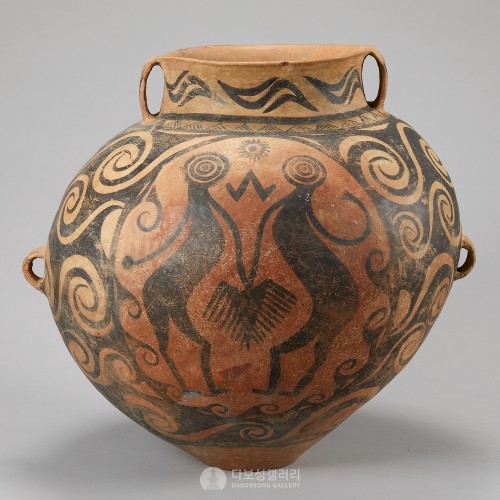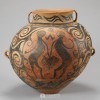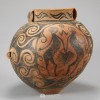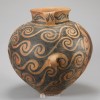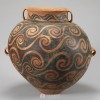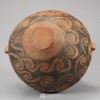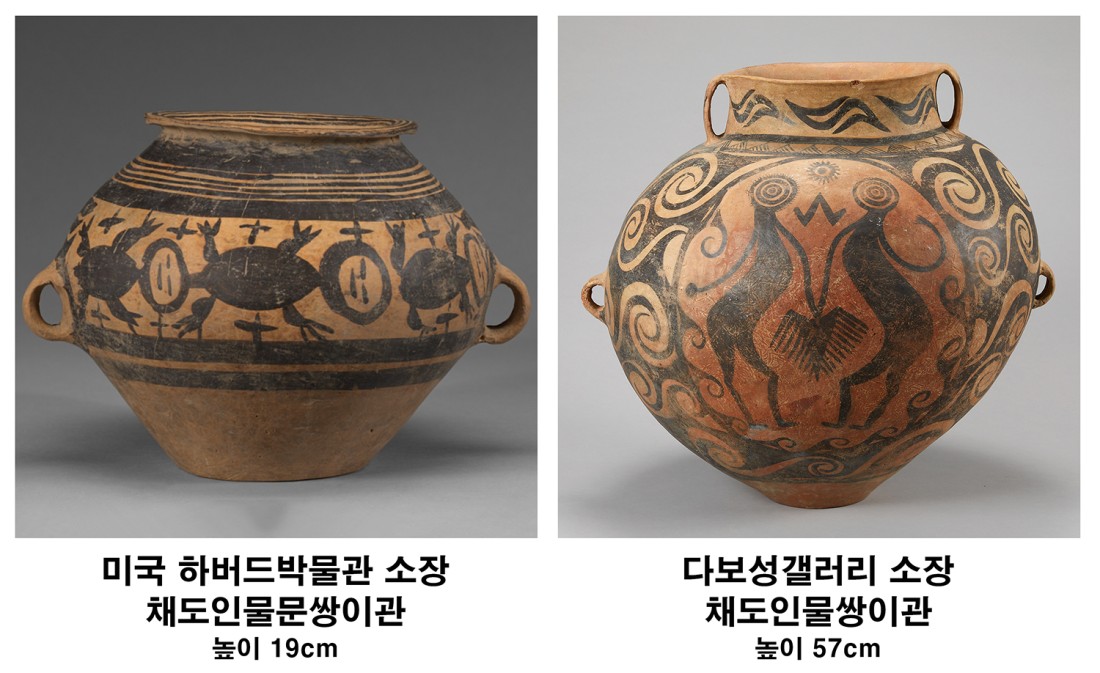본문
약간 바깥쪽으로 벌어진 구연부와 아래로 쳐지는 어깨, 배에서 굽으로 갈수록 좁아지는 기형을 갖추었습니다.
목 사이에 두 개의 귀가 대칭적으로 붙어 있고 복부의 양쪽에는 작은 고리 형태의 두 귀가 대칭적으로 붙어 있습니다. 몸통은 좌우가 비대칭이고, 굽은 몸통에 비해 아주 작습니다. 몸통에는 검정색으로 날렵한 곡선과 소용돌이 모양과 두 인물이 태양 아래에서 춤을 추는 듯한 모습이 그려져 있습니다. 검은 선은 매우 유려합니다. 추상적이고 날렵한 선에서 당시 화가의 높은 예술성을 확인할 수 있습니다.
중국에서 흙으로 그릇을 만드는 토기 문화는 신석기시대에 시작되어 도기 문화로 발전했습니다. 신석기시대의 중국 도기는 황하(黄河) 유역과 장강(長江) 유역·동남해안·북방 유역 등으로 광범위하게 분포합니다. 황하와 장강 중상류 지역은 채도로 유명하고, 하류 지역은 정교한 백도기(白陶器)와 흑도기(黑陶器)로 유명하며, 동남해안 지역은 경도기(硬陶器)로 대표되고, 북방 지역은 특색 있는 조형도기로 유명합니다. 신석기 도기는 제작 방법에 따라 수제(手製)·모제(模製)·완륜(慢輪)·쾌륜(快輪)으로 나뉘며, 문양으로는 압인(壓印)·박인(拍印)·각화(刻畵)·채색(彩繪)·누공(鏤孔)으로 나뉩니다. 제작 가마로는 횡혈요·수혈요가 있습니다. 이처럼 다양한 신석기시대의 다양한 도기문화는 오늘날 도자기의 모태가 되었습니다.
중국 신석기시대의 토기는 지역에 따라 다양한 양상을 보이는데, 채도(彩陶)는 앙소(仰韶) 문화를 비롯해 중국 신석기문화의 대표적인 토기로 대부분 붉은색 토기 표면에 검은 선으로 무늬를 그렸습니다. 무늬는 주로 기하학 무늬나 당시 사람들이 접촉했던 물고기, 새, 개구리, 돼지 등을 소재로 표현했습니다.
━━━━━
该彩绘陶器敞口,溜肩,腹下渐收。
颈部有一对称的双耳,腹部中部置双小耳。腹部左右不对称,底足相比腹部小很多。
腹部用流畅的黑色线条绘灵巧的曲线和漩涡纹,以及中央是两个人在太阳下跳舞的纹样,线条流畅,动感十足。抽象灵动的线条,可见当时的画师已经具有极高的艺术造诣。
在中国,土制陶器的陶器文化始于新石器时代,并发展为陶器文化。 新石器时代的中国陶器广泛分布在黄河流域、长江流域、东南沿海、北方流域等。 黄河、长江中上游地区以彩陶著称,下游地区以精美的白陶、黑陶著称,东南沿海地区以轻陶为代表,北方地区以特色造型陶器著称。新石器陶器根据制作方法分为手工、毛制、完轮、快轮,图案分为压印、剥印、刻画、彩绘、镂空。制作窑炉有横穴窑和输血窑。如此多样的新石器时代的各种陶器文化成为了当今陶瓷的雏形。中国新石器时代的陶器按照地域呈多种样式,彩陶始于仰韶文化作为中国新石器文化的代表陶器大部分是在红色陶器外壁上用黑色线条绘纹样,纹样也多为几何学图案,素材多为当时随处可见的鱼、鸟和青蛙等。
━━━━━
The jar has a slightly flared mouth, a drooping round shoulder, and a globular body.
A pair of loop handles are on both sides of the neck, and a pair of ringed handles are on both sides of the stomach. The whole figure is asymmetric, and the stomach tapers rapidly to the foot. On the exterior of the body are two figures dancing in the sun, surrounded by black spirals. These smooth abstract lines show the artistic ability of the time.
Chinse pottery began in the Neolithic period and developed into earthenware. Neolithic Chinese earthenware is widely distributed along the Yellow River, the Yangtze River, the southeast coast, and the northern basin. The upper-middle areas of the Yellow River and Yangtze River are known for painted pottery, the downstream area is known for elaborate white pottery and black pottery, the southeast coastal area is represented by hard pottery, and the northern region is famous for its distinctive shaped pottery. It is also divided into the hand-made, mold-made, slow wheel, and fast wheel by production method. The patterns are divided into stamped, printed, engraved, painted, and perforated. Kiln types include horizontal kilns and vertical kilns. As such, various pottery cultures of the Neolithic Age became the beginning of pottery today.
Chinese Neolithic pottery has various styles according to the region. Painted pottery began in Yangshao Culture and is representative of Chinese Neolithic culture. Most of the pottery is painted with black lines on the outer wall of red pottery. It is adorned with fish, birds, and frogs that could be seen everywhere at that time.
